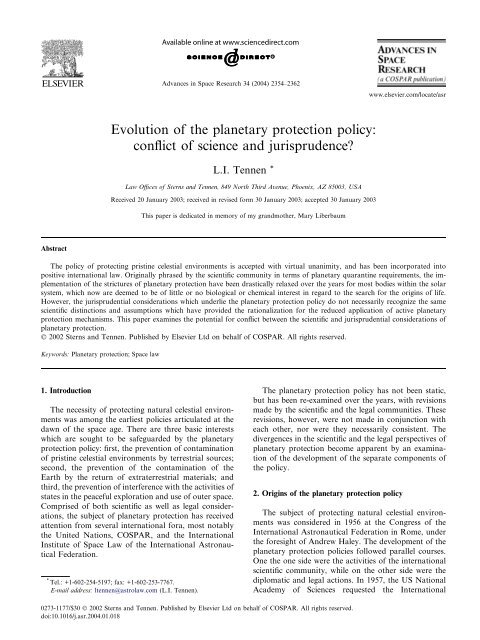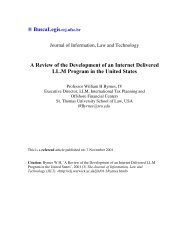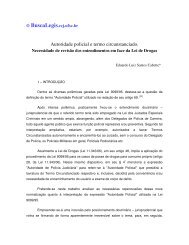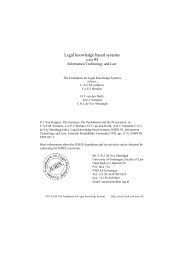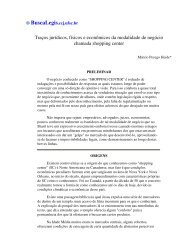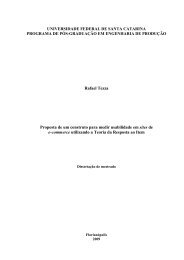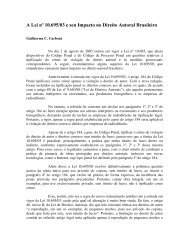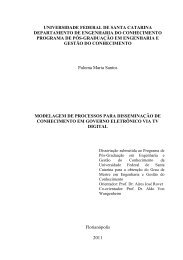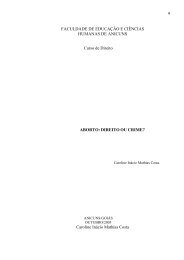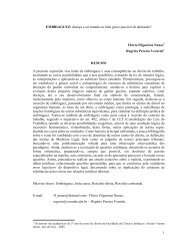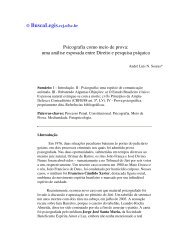Evolution of the planetary protection policy: conflict of ... - eGov UFSC
Evolution of the planetary protection policy: conflict of ... - eGov UFSC
Evolution of the planetary protection policy: conflict of ... - eGov UFSC
You also want an ePaper? Increase the reach of your titles
YUMPU automatically turns print PDFs into web optimized ePapers that Google loves.
Advances in Space Research 34 (2004) 2354–2362<br />
www.elsevier.com/locate/asr<br />
<strong>Evolution</strong> <strong>of</strong> <strong>the</strong> <strong>planetary</strong> <strong>protection</strong> <strong>policy</strong>:<br />
<strong>conflict</strong> <strong>of</strong> science and jurisprudence?<br />
L.I. Tennen *<br />
Law Offices <strong>of</strong> Sterns and Tennen, 849 North Third Avenue, Phoenix, AZ 85003, USA<br />
Received 20 January 2003; received in revised form 30 January 2003; accepted 30 January 2003<br />
This paper is dedicated in memory <strong>of</strong> my grandmo<strong>the</strong>r, Mary Liberbaum<br />
Abstract<br />
The <strong>policy</strong> <strong>of</strong> protecting pristine celestial environments is accepted with virtual unanimity, and has been incorporated into<br />
positive international law. Originally phrased by <strong>the</strong> scientific community in terms <strong>of</strong> <strong>planetary</strong> quarantine requirements, <strong>the</strong> implementation<br />
<strong>of</strong> <strong>the</strong> strictures <strong>of</strong> <strong>planetary</strong> <strong>protection</strong> have been drastically relaxed over <strong>the</strong> years for most bodies within <strong>the</strong> solar<br />
system, which now are deemed to be <strong>of</strong> little or no biological or chemical interest in regard to <strong>the</strong> search for <strong>the</strong> origins <strong>of</strong> life.<br />
However, <strong>the</strong> jurisprudential considerations which underlie <strong>the</strong> <strong>planetary</strong> <strong>protection</strong> <strong>policy</strong> do not necessarily recognize <strong>the</strong> same<br />
scientific distinctions and assumptions which have provided <strong>the</strong> rationalization for <strong>the</strong> reduced application <strong>of</strong> active <strong>planetary</strong><br />
<strong>protection</strong> mechanisms. This paper examines <strong>the</strong> potential for <strong>conflict</strong> between <strong>the</strong> scientific and jurisprudential considerations <strong>of</strong><br />
<strong>planetary</strong> <strong>protection</strong>.<br />
Ó 2002 Sterns and Tennen. Published by Elsevier Ltd on behalf <strong>of</strong> COSPAR. All rights reserved.<br />
Keywords: Planetary <strong>protection</strong>; Space law<br />
1. Introduction<br />
The necessity <strong>of</strong> protecting natural celestial environments<br />
was among <strong>the</strong> earliest policies articulated at <strong>the</strong><br />
dawn <strong>of</strong> <strong>the</strong> space age. There are three basic interests<br />
which are sought to be safeguarded by <strong>the</strong> <strong>planetary</strong><br />
<strong>protection</strong> <strong>policy</strong>: first, <strong>the</strong> prevention <strong>of</strong> contamination<br />
<strong>of</strong> pristine celestial environments by terrestrial sources;<br />
second, <strong>the</strong> prevention <strong>of</strong> <strong>the</strong> contamination <strong>of</strong> <strong>the</strong><br />
Earth by <strong>the</strong> return <strong>of</strong> extraterrestrial materials; and<br />
third, <strong>the</strong> prevention <strong>of</strong> interference with <strong>the</strong> activities <strong>of</strong><br />
states in <strong>the</strong> peaceful exploration and use <strong>of</strong> outer space.<br />
Comprised <strong>of</strong> both scientific as well as legal considerations,<br />
<strong>the</strong> subject <strong>of</strong> <strong>planetary</strong> <strong>protection</strong> has received<br />
attention from several international fora, most notably<br />
<strong>the</strong> United Nations, COSPAR, and <strong>the</strong> International<br />
Institute <strong>of</strong> Space Law <strong>of</strong> <strong>the</strong> International Astronautical<br />
Federation.<br />
* Tel.: +1-602-254-5197; fax: +1-602-253-7767.<br />
E-mail address: ltennen@astrolaw.com (L.I. Tennen).<br />
The <strong>planetary</strong> <strong>protection</strong> <strong>policy</strong> has not been static,<br />
but has been re-examined over <strong>the</strong> years, with revisions<br />
made by <strong>the</strong> scientific and <strong>the</strong> legal communities. These<br />
revisions, however, were not made in conjunction with<br />
each o<strong>the</strong>r, nor were <strong>the</strong>y necessarily consistent. The<br />
divergences in <strong>the</strong> scientific and <strong>the</strong> legal perspectives <strong>of</strong><br />
<strong>planetary</strong> <strong>protection</strong> become apparent by an examination<br />
<strong>of</strong> <strong>the</strong> development <strong>of</strong> <strong>the</strong> separate components <strong>of</strong><br />
<strong>the</strong> <strong>policy</strong>.<br />
2. Origins <strong>of</strong> <strong>the</strong> <strong>planetary</strong> <strong>protection</strong> <strong>policy</strong><br />
The subject <strong>of</strong> protecting natural celestial environments<br />
was considered in 1956 at <strong>the</strong> Congress <strong>of</strong> <strong>the</strong><br />
International Astronautical Federation in Rome, under<br />
<strong>the</strong> foresight <strong>of</strong> Andrew Haley. The development <strong>of</strong> <strong>the</strong><br />
<strong>planetary</strong> <strong>protection</strong> policies followed parallel courses.<br />
One <strong>the</strong> one side were <strong>the</strong> activities <strong>of</strong> <strong>the</strong> international<br />
scientific community, while on <strong>the</strong> o<strong>the</strong>r side were <strong>the</strong><br />
diplomatic and legal actions. In 1957, <strong>the</strong> US National<br />
Academy <strong>of</strong> Sciences requested <strong>the</strong> International<br />
0273-1177/$30 Ó 2002 Sterns and Tennen. Published by Elsevier Ltd on behalf <strong>of</strong> COSPAR. All rights reserved.<br />
doi:10.1016/j.asr.2004.01.018
L.I. Tennen / Advances in Space Research 34 (2004) 2354–2362 2355<br />
Council <strong>of</strong> Scientific Unions (ICSU) to assist in <strong>the</strong><br />
development <strong>of</strong> means to prevent contaminating celestial<br />
environments [1]. In response and reaction to <strong>the</strong><br />
launch <strong>of</strong> Sputnik, <strong>the</strong> United Nations General Assembly<br />
created <strong>the</strong> Ad Hoc Committee on <strong>the</strong> Peaceful<br />
Uses <strong>of</strong> Outer Space (COPUOS), and directed that it<br />
identify legal problems associated with <strong>the</strong> advent <strong>of</strong><br />
mankind’s exploration <strong>of</strong> space [2].<br />
3. Scientific development <strong>of</strong> <strong>the</strong> <strong>planetary</strong> <strong>protection</strong><br />
<strong>policy</strong><br />
The ICSU acted on <strong>the</strong> request <strong>of</strong> <strong>the</strong> National<br />
Academy <strong>of</strong> Sciences, and formed <strong>the</strong> Ad Hoc Committee<br />
on Contamination by Extraterrestrial Exploration<br />
(CETEX) [3]. CETEX considered celestial bodies to<br />
be scientific preserves, and stated four primary objectives:<br />
freedom <strong>of</strong> exploration <strong>of</strong> celestial bodies, subject<br />
to limitations such as <strong>planetary</strong> quarantine requirements;<br />
disclosure to COSPAR <strong>of</strong> information concerning<br />
activities and experiments; <strong>the</strong> conducting <strong>of</strong><br />
experiments only which are likely to yield useful scientific<br />
data; and nuclear explosions should not occur near<br />
<strong>the</strong> surface <strong>of</strong> celestial bodies. In <strong>the</strong> case <strong>of</strong> <strong>the</strong> Moon,<br />
CETEX also recommended that no s<strong>of</strong>t landings requiring<br />
<strong>the</strong> use <strong>of</strong> large quantities <strong>of</strong> gas should take<br />
place pending fur<strong>the</strong>r investigations [4].<br />
In 1961, pursuant to an ICSU request to assume <strong>the</strong><br />
duties <strong>of</strong> studying <strong>the</strong> potential for contamination by<br />
extraterrestrial exploration, COSPAR formed <strong>the</strong> Consultive<br />
Group on Potentially Harmful Effects <strong>of</strong> Space<br />
Experiments [5]. In 1964, <strong>the</strong> COSPAR Consultive<br />
Group published recommended <strong>planetary</strong> quarantine<br />
requirements in <strong>the</strong> form <strong>of</strong> a COSPAR resolution [6].<br />
Pursuant to <strong>the</strong> resolution, decontamination techniques<br />
were to be employed to reduce <strong>the</strong> probability <strong>of</strong> contamination<br />
<strong>of</strong> a celestial environment by a single viable<br />
terrestrial organism aboard any spacecraft intended for<br />
<strong>planetary</strong> landing or atmospheric penetration to less<br />
than 1 10 4 . The probability limit established by<br />
COSPAR for an accidental <strong>planetary</strong> impact by an unsterilized<br />
fly-by or orbiting spacecraft was to be 3 10 5<br />
or less.<br />
The probability <strong>of</strong> contamination was to be determined<br />
by a ma<strong>the</strong>matical formula, which multiplied <strong>the</strong><br />
initial microbial burden, after decontamination, <strong>of</strong> an<br />
inter<strong>planetary</strong> probe at launch, by factors relating to <strong>the</strong><br />
probability <strong>of</strong> survival <strong>of</strong> <strong>the</strong> rigors <strong>of</strong> launch, transit,<br />
entry, release and growth in <strong>the</strong> target alien environment.<br />
These <strong>planetary</strong> quarantine requirements were to<br />
apply for <strong>the</strong> initial period <strong>of</strong> <strong>planetary</strong> exploration <strong>of</strong><br />
10 years [7]. Nations were allocated specific fractions <strong>of</strong><br />
<strong>the</strong> overall probability limits which were apportioned by<br />
<strong>the</strong> recipient state among <strong>the</strong> missions planned to be<br />
conducted under its jurisdiction [8].<br />
The <strong>planetary</strong> quarantine requirements were re-examined<br />
periodically, and revisions made <strong>the</strong>reto, <strong>of</strong>ten<br />
at <strong>the</strong> initiative <strong>of</strong> NASA [9]. In 1969, COSPAR revised<br />
<strong>the</strong> <strong>planetary</strong> quarantine requirements, and stated:<br />
as <strong>the</strong> basic objective for <strong>planetary</strong> quarantine <strong>of</strong> Mars and<br />
o<strong>the</strong>r planets deemed important for <strong>the</strong> investigation <strong>of</strong> extraterrestrial<br />
life, or precursors or remnants <strong>the</strong>re<strong>of</strong>, a probability<br />
<strong>of</strong> no more than 1 10 3 that a planet will be contaminated<br />
during <strong>the</strong> period <strong>of</strong> biological exploration ...ending in 1988<br />
[10].<br />
This decision by COSPAR made two significant alterations<br />
to <strong>the</strong> <strong>planetary</strong> quarantine requirements: first, it<br />
reduced <strong>the</strong> probability <strong>of</strong> contamination limit by a full<br />
order <strong>of</strong> magnitude; second, it limited <strong>the</strong> application <strong>of</strong><br />
<strong>the</strong> quarantine requirements to ‘‘Mars and o<strong>the</strong>r planets<br />
deemed important’’ in <strong>the</strong> search for extraterrestrial life.<br />
In 1978, <strong>the</strong> Space Studies Board (SSB) <strong>of</strong> <strong>the</strong> National<br />
Research Council re-evaluated <strong>the</strong> application <strong>of</strong><br />
<strong>the</strong> formula for determining <strong>the</strong> probability <strong>of</strong> contamination.<br />
The SSB concluded that for many <strong>planetary</strong><br />
bodies <strong>of</strong> <strong>the</strong> solar system, <strong>the</strong> probability <strong>of</strong> growth <strong>of</strong> a<br />
terrestrial organism in <strong>the</strong>ir hostile extraterrestrial environments<br />
was sufficiently low so as to negate <strong>the</strong> necessity<br />
<strong>of</strong> engaging in any active decontamination<br />
techniques [11]. As a matter <strong>of</strong> <strong>policy</strong>, <strong>the</strong> assignment <strong>of</strong><br />
negligible values to <strong>the</strong> probability <strong>of</strong> growth factors<br />
began to transform <strong>planetary</strong> <strong>protection</strong> from <strong>the</strong><br />
<strong>planetary</strong> quarantine requirements, whereby <strong>the</strong> application<br />
<strong>of</strong> active bioload reduction techniques would no<br />
longer be <strong>the</strong> norm but would be <strong>the</strong> exception [12].<br />
In 1984, <strong>the</strong> transformation from <strong>planetary</strong> quarantine<br />
requirements was completed, when <strong>the</strong> applicable<br />
guidelines were relaxed to provide that <strong>planetary</strong><br />
<strong>protection</strong> constraints may be imposed, depending<br />
upon <strong>the</strong> nature <strong>of</strong> <strong>the</strong> mission and <strong>the</strong> target body or<br />
bodies to be explored. These guidelines completely<br />
eliminated <strong>the</strong> overall probability <strong>of</strong> contamination<br />
restrictions. For missions to target bodies which were<br />
deemed not to be <strong>of</strong> biological interest in <strong>the</strong> search<br />
for life, including <strong>the</strong> Moon, <strong>the</strong> <strong>policy</strong> did not require<br />
any <strong>planetary</strong> <strong>protection</strong> techniques to be utilized, nor<br />
was any specific documentation required. The classification<br />
<strong>of</strong> missions to o<strong>the</strong>r target bodies was to be<br />
determined on a case by case basis for <strong>planetary</strong><br />
<strong>protection</strong> purposes [13].<br />
The <strong>planetary</strong> <strong>protection</strong> <strong>policy</strong> was revisited again<br />
and revised in 1994, particularly in relation to exploratory<br />
missions to Mars. Specifically, <strong>the</strong> 1994 revisions<br />
to <strong>the</strong> <strong>policy</strong> tied <strong>the</strong> utilization <strong>of</strong> decontamination and<br />
cleanliness controls to whe<strong>the</strong>r <strong>the</strong> mission objectives<br />
included life-detection experiments. That is, craft landing<br />
on Mars which carried life detection instruments<br />
were subject to Viking level sterilization. However,<br />
landing craft without such life detection instruments<br />
were subject to substantially less stringent decontamination<br />
techniques [14].
2356 L.I. Tennen / Advances in Space Research 34 (2004) 2354–2362<br />
Pending before COSPAR is a proposed update and<br />
consolidation <strong>of</strong> <strong>the</strong> <strong>planetary</strong> <strong>protection</strong> <strong>policy</strong>. Pursuant<br />
to this proposal, <strong>planetary</strong> missions will be classified<br />
into one <strong>of</strong> five categories, depending upon <strong>the</strong><br />
pre-determined ‘‘<strong>planetary</strong> <strong>protection</strong> status’’ <strong>of</strong> <strong>the</strong><br />
target body, and <strong>the</strong> mission plan. The categories range<br />
from targets which are ‘‘not <strong>of</strong> direct interest for understanding<br />
<strong>the</strong> process <strong>of</strong> biological or chemical evolution’’,<br />
to missions which involve <strong>the</strong> return <strong>of</strong><br />
extraterrestrial samples to Earth [15]. An intermediate<br />
category has been introduced for <strong>planetary</strong> bodies<br />
which, while <strong>of</strong> interest concerning biological or chemical<br />
evolution, can be considered to present ‘‘only a remote<br />
chance that contamination by spacecraft could<br />
jeopardize future exploration’’ [16].<br />
Stringent bioload reduction requirements are imposed<br />
only for a limited range <strong>of</strong> missions, to a small<br />
number <strong>of</strong> target bodies, notably Mars and Europa.<br />
Viking level sterilization is mandated only for landing<br />
craft which are intended to conduct life detection experiments.<br />
O<strong>the</strong>r landing crafts and fly-by missions are<br />
subject to lesser strictures, with a notable exception: a<br />
new category, that <strong>of</strong> ‘‘special region’’, has been established,<br />
where it is believed that H 2 O, in <strong>the</strong> form <strong>of</strong><br />
surface or subsurface ice, may be present. For <strong>the</strong>se<br />
‘‘special regions’’, landing craft must achieve Viking<br />
level sterility, even where <strong>the</strong> craft is not intended to<br />
conduct life detection experiments [17].<br />
4. Jurisprudential development <strong>of</strong> <strong>the</strong> <strong>planetary</strong> <strong>protection</strong><br />
<strong>policy</strong><br />
The General Assembly directed <strong>the</strong> Ad Hoc COP-<br />
UOS to identify <strong>the</strong> legal issues presented by <strong>the</strong><br />
movement <strong>of</strong> mankind into space. In July, 1959, <strong>the</strong> Ad<br />
Hoc COPUOS reported:<br />
Scientific studies indicate that certain activities related to lunar<br />
and <strong>planetary</strong> impacts might result in biological, chemical, and<br />
radiation contamination jeopardizing subsequent physical and<br />
chemical studies and endangering possible living organisms. Release<br />
<strong>of</strong> chemical markers, radio-activity resulting from nuclear<br />
explosions, generation <strong>of</strong> gases in connexion (sic) with ‘s<strong>of</strong>t’<br />
landings and <strong>the</strong> spreading <strong>of</strong> terrestrial micro-organisms carried<br />
within space vehicles represent possible sources <strong>of</strong> contamination<br />
to <strong>the</strong> moon and planets. The re-entry <strong>of</strong> space vehicles<br />
which have effected landings on <strong>the</strong> moon and planets might<br />
contaminate <strong>the</strong> earth on <strong>the</strong>ir return. It will probably be desirable<br />
to continue such studies <strong>of</strong> this problem as are already under<br />
way, for example, in COSPAR, with a view to arriving at<br />
appropriate agreements to minimize <strong>the</strong> adverse effects <strong>of</strong> possible<br />
biological, radiological, and chemical contamination [18].<br />
In March <strong>of</strong> 1962, Chairman Khrushchev wrote an<br />
eloquent letter to President Kennedy about, what he<br />
termed, ‘‘heavenly matters’’. Included in <strong>the</strong> points he<br />
urged to be considered was: ‘‘It should, perhaps, be<br />
specified that any experiments in outer space which may<br />
hinder <strong>the</strong> exploration <strong>of</strong> space by o<strong>the</strong>r countries<br />
should be <strong>the</strong> subject <strong>of</strong> preliminary discussion and <strong>of</strong><br />
an agreement concluded on a proper international<br />
basis’’ [19]. In this letter, <strong>the</strong> issue <strong>of</strong> contamination <strong>of</strong> a<br />
celestial environment was inexorably linked to <strong>the</strong> potential<br />
for such contamination to interfere with <strong>the</strong><br />
rights <strong>of</strong> states to conduct activities in space. The focus<br />
<strong>of</strong> concern was not on <strong>the</strong> negative impact contamination<br />
may have on <strong>the</strong> celestial body, but ra<strong>the</strong>r with<br />
how <strong>the</strong> contamination may impact on <strong>the</strong> activities <strong>of</strong><br />
o<strong>the</strong>r states.<br />
Khrushchev’s letter was only one <strong>of</strong> several significant<br />
events which occurred in 1962 that would have<br />
important implications for <strong>planetary</strong> <strong>protection</strong>. COP-<br />
UOS, which by <strong>the</strong>n was a permanent Committee reporting<br />
to <strong>the</strong> General Assembly [20], agreed to establish<br />
two sub-committees: a legal sub-committee, and a scientific<br />
and technical subcommittee [21]. COPUOS also<br />
agreed to dispense with voting and conduct its activities<br />
on <strong>the</strong> basis <strong>of</strong> consensus [22]. Finally, <strong>the</strong> Soviet Union<br />
submitted for consideration a draft document entitled<br />
‘‘Declaration <strong>of</strong> <strong>the</strong> Basic Principles governing <strong>the</strong> Activities<br />
<strong>of</strong> States pertaining to <strong>the</strong> Exploration and Use<br />
<strong>of</strong> Outer Space’’ [23].<br />
The proposal <strong>of</strong> <strong>the</strong> Soviet Union incorporated <strong>the</strong><br />
linkage established by Khrushchev between contamination<br />
<strong>of</strong> a celestial environment and interference with<br />
<strong>the</strong> activities <strong>of</strong> o<strong>the</strong>r states. The USSR Draft Declaration<br />
provided:<br />
6. Co-operation and mutual assistance in <strong>the</strong> conquest <strong>of</strong> outer<br />
space shall be a duty incumbent on all States; <strong>the</strong> implementation<br />
<strong>of</strong> any measures that might in any way hinder <strong>the</strong> exploration<br />
or use <strong>of</strong> outer space for peaceful purposes by o<strong>the</strong>r<br />
countries shall be permitted only after prior discussion <strong>of</strong> and<br />
agreement upon such measures between <strong>the</strong> countries concerned<br />
[24].<br />
The primary thrust <strong>of</strong> this proposal was to give states a<br />
veto over <strong>the</strong> activities <strong>of</strong> o<strong>the</strong>r states by withholding<br />
agreement. The interest in maintaining <strong>the</strong> integrity <strong>of</strong><br />
pristine celestial environments was implied only obliquely<br />
in <strong>the</strong> Soviet draft. During <strong>the</strong> course <strong>of</strong> <strong>the</strong><br />
discussions <strong>of</strong> <strong>the</strong> COPUOS Legal Sub-Committee,<br />
some representatives noted this deficiency, and it was<br />
suggested that ‘‘prevention <strong>of</strong> contamination <strong>of</strong> or from<br />
outer space and celestial bodies’’ be given fur<strong>the</strong>r examination<br />
[25]. Such fur<strong>the</strong>r examination was conducted<br />
<strong>the</strong> following year by both <strong>the</strong> COPUOS Scientific and<br />
Technical Sub-Committee, as well as by <strong>the</strong> Legal Sub-<br />
Committee.<br />
The Legal Sub-Committee reached consensus on <strong>the</strong><br />
Soviet draft Declaration <strong>of</strong> Principles in 1963. The<br />
Declaration set forth several fundamental principles to<br />
govern <strong>the</strong> movement <strong>of</strong> mankind into space, including<br />
<strong>the</strong> non-appropriation doctrine, and that outer space is<br />
to be utilized exclusively for peaceful purposes [26].<br />
Significantly, among <strong>the</strong> initial principles adopted by <strong>the</strong><br />
global community was:
L.I. Tennen / Advances in Space Research 34 (2004) 2354–2362 2357<br />
6. In <strong>the</strong> exploration and use <strong>of</strong> outer space, States shall be<br />
guided by <strong>the</strong> principle <strong>of</strong> co-operation and mutual assistance<br />
and shall conduct all <strong>the</strong>ir activities in outer space with due regard<br />
for <strong>the</strong> corresponding interests <strong>of</strong> o<strong>the</strong>r States. If a State<br />
has reason to believe that an outer space activity or experiment<br />
planned by it or its nationals would cause potentially harmful<br />
interference with activities <strong>of</strong> o<strong>the</strong>r States in <strong>the</strong> peaceful exploration<br />
and use <strong>of</strong> outer space, it shall undertake appropriate international<br />
consultations before proceeding with any such<br />
activity or experiment. A State which has reason to believe that<br />
an outer space activity or experiment planned by ano<strong>the</strong>r State<br />
would cause potentially harmful interference with activities in<br />
<strong>the</strong> peaceful exploration and use <strong>of</strong> outer space may request<br />
consultation concerning <strong>the</strong> activity or experiment.<br />
Paragraph 6 <strong>of</strong> <strong>the</strong> Declaration incorporated <strong>the</strong><br />
consultation concept embodied in <strong>the</strong> USSR draft proposal,<br />
and maintained <strong>the</strong> nexus between <strong>the</strong> contamination<br />
<strong>of</strong> a celestial environment and interference with<br />
<strong>the</strong> activities <strong>of</strong> o<strong>the</strong>r states. It was noted by COPUOS<br />
that this provision took into account <strong>the</strong> conclusion <strong>of</strong><br />
<strong>the</strong> Scientific and Technical Sub-Committee that <strong>the</strong><br />
problem <strong>of</strong> preventing potentially harmful interference<br />
with <strong>the</strong> peaceful uses <strong>of</strong> outer space required urgent<br />
attention [27]. The Canadian delegation commented that<br />
states were not specifically asked in <strong>the</strong> Declaration to<br />
partake in consultations if an experiment would harm<br />
<strong>the</strong> natural environment <strong>of</strong> <strong>the</strong> Earth. However, <strong>the</strong>y<br />
were confident that any state contemplating such an<br />
experiment ‘‘would spontaneously undertake consultation’’<br />
[28]. On November 22, 1963, COPUOS unanimously<br />
agreed to submit <strong>the</strong> Declaration <strong>of</strong> Principles to<br />
<strong>the</strong> General Assembly, which adopted <strong>the</strong> instrument as<br />
Resolution 1962 in December, 1963 [29].<br />
The Scientific and Technical Sub-Committee took<br />
keen interest in <strong>the</strong> COSPAR <strong>planetary</strong> quarantine requirements<br />
recommended by <strong>the</strong> Consultive Group on<br />
Potentially Harmful Effects <strong>of</strong> Space Experiments in<br />
1964. The matter was considered sufficiently significant<br />
that COPUOS reprinted in its <strong>of</strong>ficial report <strong>the</strong> full<br />
COSPAR resolution <strong>of</strong> May, 1964 [30]. The Chairman<br />
<strong>of</strong> COPUOS remarked, in his opening statement, ‘‘For<br />
<strong>the</strong> first time since <strong>the</strong> United Nations has been dealing<br />
with outer-space matters, reference has been made in <strong>the</strong><br />
Scientific Sub-Committee’s report to a COSPAR resolution<br />
<strong>of</strong> 20 May 1964, affirming that <strong>the</strong> search for<br />
extra-terrestrial life is an important objective <strong>of</strong> outer<br />
space research’’ [31].<br />
The Scientific and Technical Sub-Committee recommended<br />
a form <strong>of</strong> resolution to be adopted by COSPAR<br />
as follows:<br />
Urges that all Member States proposing to carry out experiments<br />
in space should give full consideration to <strong>the</strong> problem<br />
<strong>of</strong> possible interference with o<strong>the</strong>r peaceful uses <strong>of</strong> outer space,<br />
as well as <strong>of</strong> possible harmful changes in <strong>the</strong> natural environment<br />
caused by space activities and, where Member States consider<br />
it appropriate, should seek a scientific analysis <strong>of</strong> <strong>the</strong><br />
qualitative and quantitative aspects <strong>of</strong> those experiments from<br />
<strong>the</strong> COSPAR Consultative Group on Potentially Harmful<br />
Effects <strong>of</strong> Space Experiments, and should give due consideration<br />
to <strong>the</strong> results <strong>of</strong> this analysis; this does not preclude o<strong>the</strong>r<br />
recourse to international consultations as provided for in General<br />
Assembly resolution 1962 (XVIII) [32].<br />
The Report <strong>of</strong> COPUOS additionally noted <strong>the</strong> Report<br />
<strong>of</strong> <strong>the</strong> Executive Council <strong>of</strong> <strong>the</strong> COSPAR Consultative<br />
Group, which stated: ‘‘The Group recommends<br />
early action to declare Mars a biological preserve to<br />
ensure that in <strong>the</strong> exploration <strong>of</strong> this planet, considerations<br />
<strong>of</strong> biological research receive priority over o<strong>the</strong>rs<br />
(emphasis added)’’ [33]. Finally, COPUOS recognized<br />
<strong>the</strong> Report <strong>of</strong> <strong>the</strong> Panel on Standards for Space Probe<br />
Sterilization, which stated:<br />
3. A study <strong>of</strong> <strong>the</strong> prebiological chemistry <strong>of</strong> a planet which<br />
proves to be sterile would never<strong>the</strong>less be <strong>of</strong> major biological<br />
significance [34].<br />
The standards <strong>of</strong> space vehicle sterilization are, we believe,<br />
unrelated to <strong>the</strong> probability <strong>of</strong> indigenous life on a planet in<br />
question; except in <strong>the</strong> limiting case that indigenous life and<br />
<strong>the</strong> proliferation <strong>of</strong> terrestrial contaminants can both be firmly<br />
excluded. While <strong>the</strong>re is a sizeable probability that <strong>the</strong> surface<br />
temperatures <strong>of</strong> Venus are too high for ei<strong>the</strong>r indigenous or exogenous<br />
organisms, this conclusion is based on indirect lines <strong>of</strong><br />
argument. Also, we cannot entirely exclude <strong>the</strong> possibility <strong>of</strong> biological<br />
contamination <strong>of</strong> <strong>the</strong> clouds <strong>of</strong> Venus. Until unambiguous<br />
astronomical information is available, we recommend that<br />
Martian standards <strong>of</strong> sterility control should also apply to Venus.<br />
In <strong>the</strong> case <strong>of</strong> <strong>the</strong> Moon, <strong>the</strong> surface conditions are rigorous<br />
enough to reliably exclude biological contamination <strong>of</strong> <strong>the</strong><br />
surface. We cannot exclude <strong>the</strong> possibility that conditions several<br />
tens <strong>of</strong> metres below <strong>the</strong> lunar surface will permit microbial<br />
replication. Such depths, however, are unlikely to be reached<br />
unintentionally during lunar landings. Accordingly, we recommend<br />
such less rigorous sterilization techniques as biocleanroom<br />
assembly and terminal gaseous sterilization <strong>of</strong> all<br />
spacecraft intended for lunar landings; but rigorous sterilization<br />
<strong>of</strong> drills designed for lunar subsurface boring. Our information<br />
about <strong>the</strong> conditions on o<strong>the</strong>r planets is insufficient to form a<br />
basis for definitive recommendations at this time [35].<br />
The parallel courses in <strong>the</strong> development <strong>of</strong> <strong>the</strong> <strong>planetary</strong><br />
<strong>protection</strong> <strong>policy</strong> converged in COPUOS. From<br />
<strong>the</strong> perspective <strong>of</strong> jurisprudence, <strong>the</strong> Legal Sub-Committee<br />
had drafted <strong>the</strong> Declaration <strong>of</strong> Principles which<br />
was approved by <strong>the</strong> General Assembly. On <strong>the</strong> scientific<br />
side, <strong>the</strong> Scientific and Technical Sub-Committee<br />
recognized, endorsed and encouraged <strong>the</strong> dissemination<br />
<strong>of</strong> and adherence to <strong>the</strong> stringent <strong>planetary</strong> quarantine<br />
requirements adopted by COSPAR.<br />
The COSPAR <strong>planetary</strong> quarantine requirements<br />
were a function <strong>of</strong> scientific self-regulation, but did not<br />
carry <strong>the</strong> force <strong>of</strong> law. Similarly, <strong>the</strong> Declaration <strong>of</strong><br />
Principles, as a resolution <strong>of</strong> <strong>the</strong> General Assembly, did<br />
not constitute positive international law. It was recognized<br />
that a more formal treaty document would serve<br />
<strong>the</strong> interests <strong>of</strong> mankind in <strong>the</strong> exploration and use <strong>of</strong><br />
outer space. On May 7, 1966, President Johnson issued a<br />
statement in which he proposed a draft treaty specifically<br />
applicable to activities in outer space. Among <strong>the</strong><br />
points to be included in <strong>the</strong> consideration <strong>of</strong> such a
2358 L.I. Tennen / Advances in Space Research 34 (2004) 2354–2362<br />
treaty was to ‘‘avoid harmful contamination’’ <strong>of</strong> celestial<br />
environments [36].<br />
The following month, <strong>the</strong> US submitted a Draft<br />
Treaty Governing <strong>the</strong> Exploration <strong>of</strong> <strong>the</strong> Moon and<br />
O<strong>the</strong>r Celestial Bodies to COPUOS [37]. Article 10 <strong>of</strong><br />
<strong>the</strong> draft treaty provided that ‘‘States shall pursue<br />
studies <strong>of</strong>, and, as appropriate, take steps to avoid<br />
harmful contamination <strong>of</strong> celestial bodies and adverse<br />
changes in <strong>the</strong> environment <strong>of</strong> <strong>the</strong> Earth resulting from<br />
<strong>the</strong> return <strong>of</strong> extraterrestrial matter’’ [38]. The US draft<br />
expanded <strong>the</strong> concern regarding contamination to both<br />
forward and back contamination, and expressed <strong>the</strong><br />
rights <strong>of</strong> all states to freedom for scientific exploration.<br />
However, unlike <strong>the</strong> Declaration <strong>of</strong> Principles, <strong>the</strong> US<br />
draft did not provide for consultations for activities<br />
which may cause interference with <strong>the</strong> activities <strong>of</strong> o<strong>the</strong>r<br />
states.<br />
The Soviet Delegation, in June, 1966, made its own<br />
proposal concerning a Draft Treaty <strong>of</strong> Principles Governing<br />
<strong>the</strong> Activities <strong>of</strong> States in <strong>the</strong> Exploration and<br />
Use <strong>of</strong> Outer Space, The Moon and O<strong>the</strong>r Celestial<br />
Bodies. In article VIII <strong>of</strong> <strong>the</strong> USSR proposal, <strong>the</strong> provisions<br />
<strong>of</strong> paragraph 6 <strong>of</strong> <strong>the</strong> Declaration <strong>of</strong> Principles<br />
were restated, with <strong>the</strong> addition <strong>of</strong> <strong>the</strong> following new<br />
sentence, which was inserted after <strong>the</strong> original first<br />
sentence: ‘‘States Parties to <strong>the</strong> Treaty shall conduct<br />
research on celestial bodies in such a manner as to avoid<br />
harmful contamination’’ [39]. The US and <strong>the</strong> USSR<br />
draft treaties went beyond <strong>the</strong> provisions <strong>of</strong> paragraph 6<br />
<strong>of</strong> <strong>the</strong> Declaration <strong>of</strong> Principles by referring to <strong>the</strong><br />
concept <strong>of</strong> ‘‘avoiding harmful contamination’’ [40].<br />
The US and Soviet draft proposals were referred to<br />
<strong>the</strong> Legal Sub-Committee, which met in two sessions in<br />
<strong>the</strong> summer and fall <strong>of</strong> 1966 [41]. During <strong>the</strong> first session,<br />
discussions were conducted through a Working<br />
Group, and consensus was reached on nine articles <strong>of</strong> a<br />
proposed treaty [42]. These nine articles, in general, incorporated<br />
and carried forward <strong>the</strong> provisions <strong>of</strong> <strong>the</strong><br />
Declaration <strong>of</strong> Principles, including <strong>the</strong> <strong>policy</strong> <strong>of</strong> protecting<br />
natural celestial environments.<br />
The expression <strong>of</strong> <strong>the</strong> <strong>planetary</strong> <strong>protection</strong> <strong>policy</strong> was<br />
not met with serious opposition in <strong>the</strong> Legal Sub-<br />
Committee, and <strong>the</strong>refore did not provoke extended<br />
debate. The primary issues that emerged during <strong>the</strong><br />
discussions related to <strong>the</strong> voluntary versus compulsory<br />
nature <strong>of</strong> disclosures to be made regarding activities<br />
conducted, and <strong>the</strong> role, if any, <strong>of</strong> <strong>the</strong> Secretary-General<br />
<strong>of</strong> <strong>the</strong> United Nations [43]. Within <strong>the</strong> Legal Sub-<br />
Committee and <strong>the</strong> Working Group, only <strong>the</strong> Japanese<br />
delegation raised objections, based on its belief that<br />
nei<strong>the</strong>r proposed draft was sufficient to protect natural<br />
celestial environments, and noted: ‘‘Great care must<br />
<strong>the</strong>refore be taken to preserve <strong>the</strong>ir resources and <strong>the</strong>ir<br />
natural milieu’’ [44].<br />
The Japanese delegation was not convinced that <strong>the</strong><br />
text, as adopted by <strong>the</strong> Working Group, was adequate<br />
to require states to exercise maximum care for <strong>the</strong><br />
preservation and conservation <strong>of</strong> <strong>the</strong> natural resources<br />
and environment <strong>of</strong> celestial bodies. Japan was unsuccessful<br />
in <strong>of</strong>fering an amendment to that effect. The<br />
Japanese delegation suspected that <strong>the</strong> amendment was<br />
rejected due to fears that it might unduly restrict future<br />
activities on celestial bodies. In <strong>the</strong> view <strong>of</strong> Japan’s<br />
delegation, such fears were groundless, but in a spirit <strong>of</strong><br />
co-operation did not press <strong>the</strong> amendment, <strong>the</strong>reby allowing<br />
consensus to be achieved [45].<br />
The language that emerged as article IX <strong>of</strong> <strong>the</strong> Outer<br />
Space Treaty [46] is as follows:<br />
In <strong>the</strong> exploration and use <strong>of</strong> outer space, including <strong>the</strong> moon<br />
and o<strong>the</strong>r celestial bodies, States Parties to <strong>the</strong> Treaty shall be<br />
guided by <strong>the</strong> principle <strong>of</strong> co-operation and mutual assistance<br />
and shall conduct all <strong>the</strong>ir activities in outer space, including<br />
<strong>the</strong> moon and o<strong>the</strong>r celestial bodies, with due regard to <strong>the</strong> corresponding<br />
interests <strong>of</strong> all o<strong>the</strong>r States Parties to <strong>the</strong> Treaty.<br />
States Parties to <strong>the</strong> Treaty shall pursue studies <strong>of</strong> outer space,<br />
including <strong>the</strong> moon and o<strong>the</strong>r celestial bodies, and conduct exploration<br />
<strong>of</strong> <strong>the</strong>m so as to avoid <strong>the</strong>ir harmful contamination<br />
and also adverse changes in <strong>the</strong> environment <strong>of</strong> <strong>the</strong> Earth resulting<br />
from <strong>the</strong> introduction <strong>of</strong> extraterrestrial matter and,<br />
where necessary, shall adopt appropriate measures for this purpose.<br />
If a State Party to <strong>the</strong> Treaty has reason to believe that an<br />
activity or experiment planned by it or its nationals in outer<br />
space, including <strong>the</strong> moon and o<strong>the</strong>r celestial bodies, would<br />
cause potentially harmful interference with activities <strong>of</strong> o<strong>the</strong>r<br />
States Parties in <strong>the</strong> peaceful exploration and use <strong>of</strong> outer<br />
space, including <strong>the</strong> moon and o<strong>the</strong>r celestial bodies, it shall undertake<br />
appropriate international consultations before proceeding<br />
with any such activity or experiment. A State Party to <strong>the</strong><br />
Treaty which has reason to believe that an activity or experiment<br />
planned by ano<strong>the</strong>r State Party in outer space, including<br />
<strong>the</strong> moon and o<strong>the</strong>r celestial bodies, would cause potentially<br />
harmful interference with activities in <strong>the</strong> peaceful exploration<br />
and use <strong>of</strong> outer space, including <strong>the</strong> moon and o<strong>the</strong>r celestial<br />
bodies, may request consultation concerning <strong>the</strong> activity or experiment.<br />
The Working Group blended <strong>the</strong> US and Soviet<br />
drafts, and <strong>the</strong> provision as adopted was similar to<br />
paragraph 6 <strong>of</strong> <strong>the</strong> Declaration <strong>of</strong> Principles. The<br />
modifications to <strong>the</strong> text <strong>of</strong> paragraph 6 <strong>of</strong> <strong>the</strong> Declaration<br />
incorporated <strong>the</strong> terminology proposed by <strong>the</strong><br />
Soviets to protect against forward and back contamination.<br />
In addition, minor grammatical adjustments<br />
were made, and <strong>the</strong> phrase ‘‘including <strong>the</strong> moon and<br />
o<strong>the</strong>r celestial bodies’’ was added to <strong>the</strong> reference to<br />
outer space. The final modification from <strong>the</strong> Declaration<br />
restricted <strong>the</strong> applicability <strong>of</strong> <strong>the</strong> paragraph to ‘‘states<br />
parties’’, that is, all o<strong>the</strong>r states party to <strong>the</strong> treaty, ra<strong>the</strong>r<br />
than ‘‘o<strong>the</strong>r states’’ as referenced in <strong>the</strong> Declaration.<br />
On July 3, 1970, Argentina proposed a ‘‘draft<br />
agreement on <strong>the</strong> principles governing activities in <strong>the</strong><br />
use <strong>of</strong> <strong>the</strong> natural resources <strong>of</strong> <strong>the</strong> moon and o<strong>the</strong>r celestial<br />
bodies’’ [47]. This proposed agreement focused on<br />
<strong>the</strong> sharing <strong>of</strong> benefits from <strong>the</strong> use <strong>of</strong> extraterrestrial<br />
resources, and did not mention ei<strong>the</strong>r contamination <strong>of</strong>
L.I. Tennen / Advances in Space Research 34 (2004) 2354–2362 2359<br />
celestial environments nor <strong>the</strong> potential for interference<br />
with <strong>the</strong> activities <strong>of</strong> ‘‘o<strong>the</strong>r states’’ or ‘‘states party’’<br />
[48]. The following year, on June 4, 1971, <strong>the</strong> USSR<br />
proposed a ‘‘Draft Treaty Concerning <strong>the</strong> Moon’’ to <strong>the</strong><br />
General Assembly [49], which referred <strong>the</strong> document to<br />
<strong>the</strong> COPUOS Legal Sub-Committee [50]. The Soviet<br />
Draft provided, in article VI:<br />
1. States parties shall explore and use <strong>the</strong> Moon by reasonable<br />
means avoiding <strong>the</strong> disruption <strong>of</strong> <strong>the</strong> existing balance <strong>of</strong> <strong>the</strong> lunar<br />
environment.<br />
2. States Parties shall explore and use <strong>the</strong> Moon in such a way<br />
as to prevent adverse changes in <strong>the</strong> lunar environment and its<br />
contamination through <strong>the</strong> introduction <strong>of</strong> extralunar matter.<br />
Where necessary, consultations shall be held between <strong>the</strong> States<br />
Parties concerned.<br />
In 1972, <strong>the</strong> Legal Sub-Committee reported that<br />
agreement had been reached on 21 substantiative articles,<br />
including much <strong>of</strong> article VI. A lack <strong>of</strong> consensus still<br />
remained, however, concerning a number <strong>of</strong> issues, including<br />
whe<strong>the</strong>r <strong>the</strong> treaty was to be restricted to <strong>the</strong><br />
Moon or whe<strong>the</strong>r it was to include o<strong>the</strong>r celestial bodies<br />
within its scope [51]. The approved text <strong>of</strong> draft article VI,<br />
with areas <strong>of</strong> dispute in paren<strong>the</strong>ses, was as follows:<br />
1. In exploring and using <strong>the</strong> Moon (and circumlunar space)<br />
(and o<strong>the</strong>r celestial bodies) States parties shall take measures<br />
to prevent <strong>the</strong> disruption <strong>of</strong> <strong>the</strong> existing balance <strong>of</strong> (its) (<strong>the</strong>ir)<br />
environment(s) whe<strong>the</strong>r by introducing adverse changes in such<br />
environment(s) (its) (<strong>the</strong>ir) harmful contamination through <strong>the</strong><br />
introduction <strong>of</strong> extra-environmental mater or o<strong>the</strong>rwise. States<br />
parties shall also take measures to prevent harmfully affecting<br />
<strong>the</strong> environment <strong>of</strong> <strong>the</strong> earth through <strong>the</strong> introduction <strong>of</strong> extraterrestrial<br />
matter or o<strong>the</strong>rwise.<br />
2. (States parties planning missions to <strong>the</strong> Moon (and o<strong>the</strong>r celestial<br />
bodies) shall notify <strong>the</strong> Secretary-General <strong>of</strong> measures<br />
being adopted to minimize <strong>the</strong> disruption <strong>of</strong> <strong>the</strong> existing balance<br />
<strong>of</strong> <strong>the</strong> environment(s) <strong>of</strong> (those bodies). Such reports shall<br />
include <strong>the</strong> trajectories to be flown <strong>the</strong> distance <strong>of</strong> closest approach,<br />
and specific measures taken to control micro-organisms<br />
on and in <strong>the</strong> spacecraft).<br />
3. States parties shall notify <strong>the</strong> Secretary-General <strong>of</strong> plans to<br />
place radio-active material on or in orbit or o<strong>the</strong>r trajectory<br />
around <strong>the</strong> Moon (or o<strong>the</strong>r celestial bodies) and shall give similar<br />
notification with regard to <strong>the</strong> conditions and effects <strong>of</strong> such<br />
placement when it occurs.<br />
4. States parties shall report to o<strong>the</strong>r States parties and to <strong>the</strong><br />
Secretary-General concerning areas <strong>of</strong> <strong>the</strong> Moon (and o<strong>the</strong>r celestial<br />
bodies) having special scientific interest in order that consideration<br />
may be given to <strong>the</strong>ir designation as international<br />
scientific preserves for which special protective arrangements<br />
are to be agreed, without prejudice to <strong>the</strong> rights <strong>of</strong> o<strong>the</strong>r States<br />
parties to this Treaty [52].<br />
The draft text required <strong>the</strong> disclosure <strong>of</strong> detailed information,<br />
including <strong>the</strong> specific measures taken to<br />
control <strong>the</strong> number <strong>of</strong> micro-organisms on and in a<br />
spacecraft. Consensus was reached by <strong>the</strong> Legal Sub-<br />
Committee on <strong>the</strong> text <strong>of</strong> a revised draft article VI in<br />
1973. This revised text modified <strong>the</strong> reporting requirements,<br />
and combined paragraph 3 with <strong>the</strong> balance <strong>of</strong><br />
<strong>the</strong> previous paragraph 2. The revised text provided:<br />
1. In exploring and using <strong>the</strong> Moon, States parties shall take<br />
measures to prevent <strong>the</strong> disruption <strong>of</strong> <strong>the</strong> existing balance <strong>of</strong><br />
its environment whe<strong>the</strong>r by introducing adverse changes in such<br />
environment, its harmful contamination through <strong>the</strong> introduction<br />
<strong>of</strong> extra-environmental matter or o<strong>the</strong>rwise. States parties<br />
shall also take measures to prevent harmfully affecting <strong>the</strong> environment<br />
<strong>of</strong> <strong>the</strong> Earth through <strong>the</strong> introduction <strong>of</strong> extra-terrestrial<br />
matter or o<strong>the</strong>rwise.<br />
2. States parties shall inform <strong>the</strong> Secretary-General <strong>of</strong> <strong>the</strong> measures<br />
being adopted by <strong>the</strong>m in accordance with paragraph 1 <strong>of</strong><br />
this article and shall also notify him <strong>of</strong> all placements by <strong>the</strong>m<br />
<strong>of</strong> radioactive materials on <strong>the</strong> Moon and <strong>of</strong> <strong>the</strong> purposes <strong>of</strong><br />
such placements. (Points <strong>of</strong> time <strong>of</strong> information and notification<br />
to <strong>the</strong> Secretary-General to be resolved.)<br />
..<br />
4. States parties shall report to o<strong>the</strong>r States parties and to <strong>the</strong><br />
Secretary-General concerning areas <strong>of</strong> <strong>the</strong> Moon having special<br />
scientific interest in order that, without prejudice to <strong>the</strong> rights <strong>of</strong><br />
o<strong>the</strong>r States parties, consideration may be given to <strong>the</strong> designation<br />
<strong>of</strong> such areas as international scientific preserves for which<br />
special protective arrangements are to be agreed in consultation<br />
with <strong>the</strong> competent organs <strong>of</strong> <strong>the</strong> United Nations [53].<br />
The Moon Agreement incorporated this revised text,<br />
with minor modifications, as article 7 [54]. The General<br />
Assembly, without a vote, approved and opened <strong>the</strong><br />
Moon Agreement for signature in December, 1979 [55]. In<br />
addition, <strong>the</strong> General Assembly specifically took note <strong>of</strong><br />
<strong>the</strong> Report <strong>of</strong> COPUOS, which clearly expressed that <strong>the</strong><br />
intention <strong>of</strong> this article was not to prohibit exploitation <strong>of</strong><br />
natural resources, but ra<strong>the</strong>r to protect <strong>the</strong> existing balance<br />
<strong>of</strong> <strong>the</strong> natural celestial environments [56].<br />
The Moon Agreement entered into force in 1984 [57],<br />
but it has been ratified by only a handful <strong>of</strong> states [58].<br />
Never<strong>the</strong>less, <strong>the</strong> Moon Agreement does establish a legal<br />
regime applicable to <strong>the</strong> states which have ratified or<br />
signed <strong>the</strong> instrument [59]. The provisions <strong>of</strong> <strong>the</strong> Moon<br />
Agreement also may be applicable to all states which<br />
participate in a cooperative mission with one or more<br />
states which have signed <strong>the</strong> document. In such circumstances,<br />
states will have an affirmative duty to take<br />
steps to prevent <strong>the</strong> disruption <strong>of</strong> <strong>the</strong> existing balance <strong>of</strong><br />
<strong>the</strong> environment, and to inform <strong>the</strong> Secretary-General <strong>of</strong><br />
<strong>the</strong> measures so adopted.<br />
5. Conflicts between scientific and legal approaches to<br />
<strong>planetary</strong> <strong>protection</strong><br />
The <strong>planetary</strong> <strong>protection</strong> <strong>policy</strong> as set forth in <strong>the</strong> law<br />
<strong>of</strong> outer space has been consistent in both its philosophy<br />
and its expression. While modifications have been made<br />
in terminology from <strong>the</strong> Declaration <strong>of</strong> Principles, to <strong>the</strong><br />
Outer Space Treaty, to <strong>the</strong> Moon Agreement, those<br />
changes have expanded <strong>the</strong> scope <strong>of</strong> <strong>the</strong> <strong>policy</strong> to encompass<br />
<strong>the</strong> three main considerations <strong>of</strong> preventing<br />
forward contamination, back contamination, and interference<br />
with <strong>the</strong> activities <strong>of</strong> states. The corpus juris<br />
spatialis has refrained from grafting exclusions, exemp-
2360 L.I. Tennen / Advances in Space Research 34 (2004) 2354–2362<br />
tions and exceptions to <strong>the</strong> <strong>policy</strong>. The same cannot be<br />
said <strong>of</strong> <strong>the</strong> scientific approach to <strong>planetary</strong> <strong>protection</strong>.<br />
What began as a presumption by CETEX that celestial<br />
environments are scientific preserves, has evolved into a<br />
selective <strong>policy</strong> applicable only to a limited subset <strong>of</strong><br />
missions only to a limited subset <strong>of</strong> target bodies.<br />
The origins <strong>of</strong> <strong>the</strong> <strong>planetary</strong> <strong>protection</strong> <strong>policy</strong> were<br />
based on <strong>the</strong> recognition that pristine celestial environments<br />
presented a unique opportunity for scientific<br />
study and exploration which must be protected. The<br />
criterion was expressed that definitive recommendations<br />
should not be made in <strong>the</strong> absence <strong>of</strong> unambiguous astronomical<br />
information. However, alterations began to<br />
be introduced to <strong>the</strong> <strong>planetary</strong> <strong>protection</strong> <strong>policy</strong> based<br />
on indirect lines <strong>of</strong> reasoning, much <strong>of</strong> which concerned<br />
a re-evaluation <strong>of</strong> <strong>the</strong> factor <strong>of</strong> <strong>the</strong> probability <strong>of</strong> growth<br />
<strong>of</strong> a terrestrial organism in an alien environment.<br />
These alterations consistently have eroded <strong>the</strong> requirement<br />
to employ active decontamination techniques,<br />
even for Mars. The result <strong>of</strong> this process is that<br />
<strong>the</strong> original <strong>planetary</strong> quarantine requirement, i.e., that<br />
<strong>the</strong> probability <strong>of</strong> contamination by a single viable organism<br />
be less than 1 10 4 , has been eliminated in<br />
favor <strong>of</strong> a standard which can allow for a pre-launch<br />
contamination level <strong>of</strong> 300 spores per square meter for<br />
landing craft for Mars [60]. The situation is even more<br />
unsettling in relation to fly-by crafts. The probability<br />
limit <strong>of</strong> less than 3 10 5 has been abandoned, and<br />
crafts have been sent to Mars which were subject to<br />
relatively minimal decontamination techniques.<br />
The intention to conduct life detection experiments<br />
should not be <strong>the</strong> determining factor in whe<strong>the</strong>r to apply<br />
strict bioload reduction requirements to an inter<strong>planetary</strong><br />
spacecraft, nor should <strong>the</strong> presence <strong>of</strong> a craft in a<br />
‘‘special region’’. There have been significant failures <strong>of</strong><br />
both landing and fly-by craft sent to Mars in <strong>the</strong> recent<br />
past. These missions have not just ended in failure, but<br />
<strong>the</strong> space objects were lost after reaching <strong>the</strong> red planet.<br />
These lost craft could have impacted <strong>the</strong> surface at unknown<br />
locations, including within ‘‘special regions’’.<br />
Thus, probes sent to Mars, even if not intended to land<br />
in a special region, or to land at all, have carried a<br />
substantial risk <strong>of</strong> contaminating undetermined areas <strong>of</strong><br />
<strong>the</strong> planet.<br />
The reductions in <strong>the</strong> applicability <strong>of</strong> strict decontamination<br />
techniques <strong>of</strong>ten have been effected based on<br />
little or no relevant data from in situ experimentation<br />
for <strong>the</strong> search for life. Moreover, <strong>the</strong> definition <strong>of</strong> ‘‘life’’<br />
is constantly expanding, and <strong>the</strong> experimentation which<br />
has been conducted frequently enhances <strong>the</strong> arguments<br />
in favor <strong>of</strong> streng<strong>the</strong>ning ra<strong>the</strong>r than lessening <strong>the</strong><br />
<strong>planetary</strong> <strong>protection</strong> <strong>policy</strong> [61].<br />
There are two distinct developments which converge<br />
in astrobiology, and which support a robust <strong>planetary</strong><br />
<strong>protection</strong> <strong>policy</strong>: first, <strong>the</strong> discovery <strong>of</strong> H 2 O on a variety<br />
<strong>of</strong> celestial bodies, which hi<strong>the</strong>rto were unimaginable<br />
as sources <strong>of</strong> water, including <strong>the</strong> Moon, asteroids,<br />
and Mars; and second, <strong>the</strong> study <strong>of</strong> extremophiles. The<br />
confirmed discovery <strong>of</strong> water on many celestial bodies is<br />
a crucial development for <strong>the</strong> search for life on alien<br />
worlds [62]. The study <strong>of</strong> extremophiles has expanded<br />
<strong>the</strong> realm <strong>of</strong> what is considered possible for life to exist,<br />
even to thrive, in formerly unthinkably hostile environments.<br />
Clearly, <strong>the</strong> possibility must be acknowledged<br />
that life, as we are capable <strong>of</strong> detecting it, or perhaps as<br />
we are as yet unable to comprehend or even recognize,<br />
may exist or have existed in celestial environments. The<br />
indications are that we should find life on Mars, as all <strong>of</strong><br />
<strong>the</strong> essential building blocks are present. If we do not<br />
discover life, or <strong>the</strong> remnants or precursors <strong>the</strong>re<strong>of</strong>, it<br />
would underscore <strong>the</strong> uniqueness <strong>of</strong> Earth [63]. We are<br />
still in <strong>the</strong> early stages <strong>of</strong> <strong>planetary</strong> exploration and<br />
discovery, and definitive astronomical information must<br />
await future experimentation.<br />
Two revisions which have been made to <strong>the</strong> <strong>planetary</strong><br />
<strong>protection</strong> <strong>policy</strong> merit special mention, as <strong>the</strong>y represent<br />
a positive approach: first, <strong>the</strong> creation <strong>of</strong> <strong>the</strong> category<br />
<strong>of</strong> target bodies which are <strong>of</strong> interest for biological<br />
or chemical evolution, but which are considered to<br />
present only a remote chance that contamination could<br />
jeopardize future exploration; second, <strong>the</strong> establishment<br />
<strong>of</strong> ‘‘special regions’’ where it is believed H 2 O may be<br />
present. The first <strong>of</strong> <strong>the</strong>se revisions carries <strong>the</strong> implicit<br />
recognition that target bodies may be <strong>of</strong> interest in <strong>the</strong><br />
search for life, even if it is believed that target body is<br />
barren. Never<strong>the</strong>less, as recent discoveries have demonstrated,<br />
virtually all celestial bodies should be considered<br />
<strong>of</strong> potential interest for biological or chemical<br />
evolution. The ‘‘special region’’ designation, on <strong>the</strong><br />
o<strong>the</strong>r hand, while significant, also may be too restrictive,<br />
especially if <strong>the</strong> refining element is <strong>the</strong> possible existence<br />
<strong>of</strong> water. Given <strong>the</strong> extensive evidence <strong>of</strong> liquid water on<br />
<strong>the</strong> surface <strong>of</strong> Mars in <strong>the</strong> past, can <strong>the</strong> presence <strong>of</strong><br />
subsurface water, past or present, be definitively ruled<br />
out in <strong>the</strong> absence <strong>of</strong> experimentation, even in areas<br />
outside <strong>of</strong> <strong>the</strong> ‘‘special regions’’?<br />
6. Conclusion<br />
The law <strong>of</strong> outer space requires states to avoid<br />
harmful contamination <strong>of</strong> celestial environments. The<br />
corpus juris spatialis does not distinguish between celestial<br />
bodies based on whe<strong>the</strong>r or not <strong>the</strong>y are ‘‘deemed<br />
important for (<strong>the</strong>) investigation <strong>of</strong> extraterrestrial life’’<br />
[64], nor whe<strong>the</strong>r or not <strong>the</strong>y are deemed <strong>of</strong> interest for<br />
biological or chemical evolution [65]. The modifications<br />
<strong>of</strong> <strong>the</strong> <strong>planetary</strong> <strong>protection</strong> <strong>policy</strong> based on such distinctions<br />
unfortunately have failed to adequately protect<br />
Mars from possible contamination. As such, <strong>the</strong> <strong>policy</strong><br />
may be deficient vis-a-vis international treaty commitments.<br />
Moreover, <strong>the</strong> evolution <strong>of</strong> <strong>the</strong> <strong>planetary</strong> pro-
L.I. Tennen / Advances in Space Research 34 (2004) 2354–2362 2361<br />
tection <strong>policy</strong> has lost sight <strong>of</strong> one <strong>of</strong> <strong>the</strong> basic propositions<br />
on which <strong>the</strong> <strong>policy</strong> was founded: a sterile celestial<br />
environment would be <strong>of</strong> major biological<br />
significance [66]. Finally, an important distinction must<br />
be noted in <strong>the</strong> perspective <strong>of</strong> <strong>the</strong> two major disciplines<br />
engaged in <strong>the</strong> search for life on celestial bodies: astrobiologists<br />
and SETI. The <strong>planetary</strong> <strong>protection</strong> <strong>policy</strong><br />
has been driven by astrobiology, and <strong>the</strong> universe <strong>of</strong><br />
celestial bodies which are subject to rigorous <strong>planetary</strong><br />
<strong>protection</strong> techniques consistently has been reduced,<br />
based on <strong>the</strong> indirect deduction that life is incapable <strong>of</strong><br />
growth in such alien environments. The SETI community,<br />
on <strong>the</strong> o<strong>the</strong>r hand, has been actively searching <strong>the</strong><br />
skies for new <strong>planetary</strong> systems, with <strong>the</strong> implicit assumption<br />
that not just life, but intelligent life, may be<br />
present on any worlds which may be discovered. It is<br />
respectfully submitted that reductions to <strong>the</strong> <strong>planetary</strong><br />
<strong>protection</strong> <strong>policy</strong> are premature in <strong>the</strong> absence <strong>of</strong> extensive<br />
study and experimentation.<br />
References<br />
[1] See C.R. Phillips, The Planetary Quarantine Program: Origins and<br />
Achievements 3 (1975), NASA Pub. No. SP-4902, US GPO Stock<br />
No. 3300-00578; Stabekis, History and Processing <strong>of</strong> Changes, in<br />
Report, COSPAR/IAU Workshop on Planetary Protection,<br />
Appendix C, 2002.<br />
[2] G.A. Res. 1348 (December 13, 1958).<br />
[3] Phillips, supra note 1, at 3; H.S. Lay & H.J. Taubenfeld, The Law<br />
Relating to <strong>the</strong> Activities <strong>of</strong> Man in Space, An American Bar<br />
Foundation Report 189 n. 7, 1970.<br />
[4] Lay & Taubenfeld, supra note 3, at 189, n. 37; C.Q. Christol, The<br />
Modern International Law <strong>of</strong> Outer Space 132, (1982); see also<br />
CETEX, Contamination by Extraterrestrial Exploration, 183<br />
Nature 925–28 (1959); CETEX, Development <strong>of</strong> International<br />
Efforts to Avoid Contamination by Extraterrestrial Exploration,<br />
128 Science News 887–89 (1958); Atwood, Basis for <strong>the</strong> Sterility<br />
Requirement, in Spacecraft Sterilization Technology 3 (L. Hall ed.<br />
1966), NASA Pub. No. SP-108.<br />
[5] W.C. Jenks, Space Law 34 (1965).<br />
[6] COSPAR Res. 26, 20 COSPAR Info. Bull. at Annex 4 (1964); see<br />
text & notes 30-35, infra.<br />
[7] Report, Committee on <strong>the</strong> Peaceful Uses <strong>of</strong> Outer Space, at 13,<br />
U.N. Doc. A/5785 (November 13, 1964). See Committee on<br />
Planetary Biology and Chemical <strong>Evolution</strong>, Space Science Board,<br />
Recommendations on Quarantine Policy for Mars, Jupiter,<br />
Saturn, Uranus, Neptune and Titan 27 (1978).<br />
[8] Sterns & Tennen, Protection <strong>of</strong> Celestial Environments Through<br />
Planetary Quarantine Requirements, in Proceedings <strong>of</strong> <strong>the</strong> 23rd<br />
Colloquium on <strong>the</strong> Law <strong>of</strong> Outer Space 107 (1981).<br />
[9] See, e.g., Outbound Spacecraft Basic Policy Relating to Lunar and<br />
Planetary Quarantine Control, NASA Policy Directive 8020.7<br />
(1967); Outbound Planetary Biological and Organic Contamination<br />
Control, NASA Policy Directive 8020.10A (1972); Quarantine<br />
Provisions for Unmanned Extraterrestrial Missions, NASA<br />
Hand Book 8020.12A (1976); Biological Contamination Control<br />
for Outbound and Inbound Planetary Spacecraft, NASA Management<br />
Instruction 8020.7A (1988).<br />
[10] COSPAR Decision No. 16, 50 COSPAR Info. Bull. 15–16 (July,<br />
1969), quoted by Stabekis, supra note 1.<br />
[11] Space Science Board, Recommendations, supra note 7, at 27–28<br />
(Appendix C).<br />
[12] Id. Never<strong>the</strong>less, <strong>the</strong> SSB continued to recommend that crafts<br />
intended for such celestial bodies employ clean room techniques.<br />
It justified such recommendation not on <strong>planetary</strong> <strong>protection</strong><br />
considerations, but on <strong>the</strong> basis that <strong>the</strong> use <strong>of</strong> clean rooms would<br />
reduce <strong>the</strong> possibility <strong>of</strong> growth <strong>of</strong> organisms which might<br />
compromise <strong>the</strong> functioning <strong>of</strong> <strong>the</strong> spacecraft or its payload. Id.<br />
at 15–16.<br />
[13] COSPAR Internal Decision 7/84, quoted by Stabekis, supra note<br />
1, Appendix C, at C-6.<br />
[14] See An Exobiological Strategy for Mars Exploration 49 (1995),<br />
NASA Pub. No. SP-530; see also DeVincenzi, Planetary Protection<br />
Issues and <strong>the</strong> Future Exploration <strong>of</strong> Mars, in 12 Adv. S.<br />
Res., No. 4, 121 (1992); D.L. DeVincenzi, H.P. Klein & J.R.<br />
Bagby, JR., Planetary Protection Issues and Future Mars<br />
Missions, NASA Conf. Pub. 10086 (1991).<br />
[15] See generally COSPAR/IAU Report, supra note 1.<br />
[16] Id. at chap. 1.<br />
[17] Id.<br />
[18] Report, Ad Hoc Committee on <strong>the</strong> Peaceful Uses <strong>of</strong> Outer Space,<br />
U.N. Doc. A/4141 (July 14, 1959).<br />
[19] Letter dated March 21, 1962, transmitting letter <strong>of</strong> March 20,<br />
1962, from Chairman Khrushchev to President Kennedy, at 5,<br />
U.N. Doc. A/AC.105/2 (March 21, 1962).<br />
[20] G.A. Res. 1472 (December 12, 1959).<br />
[21] Report, Committee on <strong>the</strong> Peaceful Uses <strong>of</strong> Outer Space, at 4,<br />
U.N. Doc, A/5181 (September 27, 1962).<br />
[22] Id. at 3-4.<br />
[23] Id. at 5, text reprinted in U.N. Doc. A/AC. 105/C.2/L/1.<br />
[24] Report, Legal Sub-Committee, Committee on <strong>the</strong> Peaceful Uses<br />
<strong>of</strong> Outer Space, U.N. Doc. A/AC. 105/6 (July 9, 1962).<br />
[25] Id. at 8, para. 14.<br />
[26] See, G.A. Res. 1721 (December 20, 1961).<br />
[27] Report, 1962 Legal Sub-Committee, COPUOS, supra note 24, at<br />
Annex, p. 3.<br />
[28] Id. at 10.<br />
[29] Additional Report, Committee on <strong>the</strong> Peaceful Uses <strong>of</strong><br />
Outer Space, at 2, U.N. Doc. A/5549/Add.l (November 27,<br />
1963).<br />
[30] 1964 Report <strong>of</strong> COPUOS, supra note 7, at 17.<br />
[31] Id. Annex I, at 6.<br />
[32] Id. at 17–18, para. 3.<br />
[33] Id. Annex III, at 3.<br />
[34] Id. Annex III, Appendix 4, at 11.<br />
[35] Id. at 13–14.<br />
[36] Christol, supra note 4, at 134, n. 16; Agreement Governing <strong>the</strong><br />
Activities <strong>of</strong> States on <strong>the</strong> Moon and O<strong>the</strong>r Celestial Bodies,<br />
Senate, Comm. On Commerce, Science and Transportation, 96th<br />
Cong., 2nd Sess., 5–6 (Comm. Print 1980).<br />
[37] U.N. Doc. A/AC.105/32 (June 17, 1966).<br />
[38] Id. at 6.<br />
[39] Report, Legal Sub-Committee,Committee on <strong>the</strong> Peaceful Uses <strong>of</strong><br />
Outer Space, Annex I, at 11, U.N. Doc. A/AC. 105/35 (September<br />
16, 1966); see also Report, Committee on <strong>the</strong> Peaceful Uses <strong>of</strong><br />
Outer Space, U.N. Doc. A/6431 (September 22, 1966) (US and<br />
USSR drafts).<br />
[40] Christol, supra note 4, at 135.<br />
[41] 1966 Report <strong>of</strong> COPUOS, supra note 39, at 1, para. 1.<br />
[42] Id. at para. 3.<br />
[43] See generally Legal Sub-Committee, Committee on <strong>the</strong> Peaceful<br />
Uses <strong>of</strong> Outer Space, Summary Record <strong>of</strong> <strong>the</strong> 68th Meeting, 26<br />
July 1966, Geneva, at 3–11, U.N. Doc. A/AC. 105/C.2/SR.68<br />
(October 21, 1966) (statements <strong>of</strong> USSR, US, Japan, and<br />
Canada); Legal Sub-Committee, Committee on <strong>the</strong> Peaceful Uses<br />
<strong>of</strong> Outer Space, Summary Record <strong>of</strong> <strong>the</strong> 71st Meeting, 4 August<br />
1966, Geneva, U.N. Doc. A/AC.105/C.2/SR.71 and Add.l, at 13–<br />
14 (October 21, 1966) (statements <strong>of</strong> Japan, Australia, and<br />
Bulgaria).
2362 L.I. Tennen / Advances in Space Research 34 (2004) 2354–2362<br />
[44] Legal Sub-Committee, COPUOS, Summary Record <strong>of</strong> <strong>the</strong> 68th<br />
Meeting, supra note 43, at 6.<br />
[45] Legal Sub-Committee, COPUOS, Summary Record <strong>of</strong> <strong>the</strong> 71st<br />
Meeting, supra note 43, at 13–14.<br />
[46] Treaty on Principles Governing <strong>the</strong> Activities <strong>of</strong> States in <strong>the</strong><br />
Exploration and Use <strong>of</strong> Outer Space, Including <strong>the</strong> Moon and<br />
O<strong>the</strong>r Celestial Bodies, opened for signature January 27, 1967, 18<br />
U.S.T. 2410, T.I.A.S. No. 6347, 610 U.N.T.S. 205, text reproduced<br />
in United Nations Treaties and Principles on Outer Space 3<br />
(2002) [hereinafter referred to as <strong>the</strong> Outer Space Treaty].<br />
[47] Report, Legal Sub-Committee, Committee on <strong>the</strong> Peaceful Uses<br />
<strong>of</strong> Outer Space, Annex I, at 6–7, U.N. Doc. A/AC.105/101 (May<br />
11, 1972).<br />
[48] Committee On Commerce, Science and Transportation, supra<br />
note 36, at 7.<br />
[49] U.N. Doc. A/8391 and Corr. 1, annex (1971); see also U.N. Doc.<br />
A/AC.1/L.568 (November 5, 1971).<br />
[50] G.A. Res. 279 (XXVI) (November 29, 1971).<br />
[51] Report, Committee on <strong>the</strong> Peaceful Uses <strong>of</strong> Outer Space, GAOR<br />
27th Session (Supp. 20), Part II, Report, Legal Sub-Committee, at<br />
3, para. 12, U.N. Doc. A/8720 (1972).<br />
[52] Report, Committee on <strong>the</strong> Peaceful Uses <strong>of</strong> Outer Space, 28th<br />
Session (Supp. 20), at 28, U.N. Doc. A/9020 (1973).<br />
[53] Id. at 34–35. References to <strong>the</strong> moon were considered to include<br />
o<strong>the</strong>r celestial bodies as well. See id. at 25, n. a.<br />
[54] The modifications were, in paragraph 1, <strong>the</strong> terms ‘‘that was<br />
substituted for ‘‘such and ‘‘avoid for ‘‘prevent; in paragraph 2,<br />
notification was to be made to <strong>the</strong> maximum extent feasible in<br />
advance; and paragraph 4 was renumbered to paragraph 3.<br />
[55] G.A. Res. 34/68, U.N. Doc. A/RES/34/68 (December 14,<br />
1979).<br />
[56] See Committee on Science, Technology & Commerce, supra note<br />
36, at 44.<br />
[57] Agreement Governing <strong>the</strong> Activities <strong>of</strong> States on <strong>the</strong> Moon and<br />
O<strong>the</strong>r Celestial Bodies, entered into force July 11, 1984, 1363<br />
U.N.T.S. 3, text reproduced in United Nations Treaties and<br />
Principles on Outer Space 27 (2002), and 18 I.L.M. 1434 (1979)<br />
[hereinafter referred to as <strong>the</strong> ‘‘Moon Agreement’’].<br />
[58] As <strong>of</strong> January 1, 2001, <strong>the</strong> Moon Agreement has been ratified by<br />
Australia, Austria, Chile, Kazakhstan, Mexico, Morocco, <strong>the</strong><br />
Ne<strong>the</strong>rlands, Pakistan, <strong>the</strong> Philippines, and Uruguay. In addition,<br />
<strong>the</strong> Moon Agreement has been signed by France, Guatemala,<br />
India, Peru, and Romania. See Terekov, Annual Report 2001:<br />
Status <strong>of</strong> International Agreements Relation (sic) to Activities in<br />
Outer Space, in Proceedings <strong>of</strong> <strong>the</strong> 44th COLLOQUIUM on <strong>the</strong><br />
Law <strong>of</strong> Outer Space 389, 393–401 (2002).<br />
[59] Vienna Convention on <strong>the</strong> Law <strong>of</strong> Treaties, art. 18, text<br />
reproduced in 8 I.L.M. 679 (1969).<br />
[60] Debus, Runavot, Rogovsky, Bogomolov, Khamidullina & Tr<strong>of</strong>imov,<br />
Mars 96 Planetary Protection Program and Implementation<br />
for Mars Environment Preservation, in Proceedings <strong>of</strong> <strong>the</strong> 40th<br />
COLLOQUIUM on <strong>the</strong> Law <strong>of</strong> Outer Space 220 (1998).<br />
[61] See, e.g., Hydrogen-Fed Bacteria May Exist Beyond Earth,<br />
NASA Press Release 02-37AR (April 3, 2002); ‘‘NASA Scientists<br />
Create Amino Acids in Deep-Space-Like Environment’’, NASA<br />
Press Release 02-33AR (March 27, 2002).<br />
[62] ‘‘Jupiter’s Moon UA Scientist Finds Water and Life Sustaining<br />
Nutrients on Europa’’, University <strong>of</strong> Arizona, Report on Research<br />
5 (2002); ‘‘Odyssey Finds Water Ice in Abundance<br />
Under Mars’ Surface’’, 2001 Mars Odyssey Press Release (May<br />
28, 2002).<br />
[63] 1964 Report <strong>of</strong> COPUOS, supra note 7, Annex III, at 3.<br />
[64] COSPAR Decision 16, supra note 10.<br />
[65] COSPAR/IAU Report, supra note 1.<br />
[66] 1964 Report <strong>of</strong> COPUOS, supra note 7, Annex III, appendix 4,<br />
at 11.


